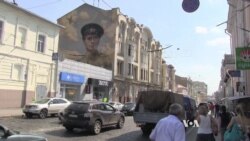ທຸລະກິດ ຢູເຄຣນ ຫຼາຍແຫ່ງໃນເວລານີ້ ແມ່ນກຳລັງປ່ຽນແປງວິທີເຮັດກິດຈະການຂອງເຂົາເຈົ້າ. ເຂົາເຈົ້າແມ່ນໄດ້ເລີ່ມຈາກການສ້າງລາຍໄດ້ ໄປຫາການເຮັດວັດຖຸສົງຄາມ. ນັກຂ່າວວີໂອເອ ລີເຊຍ ບາກາເລັດສ໌ (Lesia Bakalets) ມີລາຍງານ, ເຊິ່ງ ພຸດທະສອນ ຈະນຳລາຍລະອຽດມາສະເໜີທ່ານໃນອັນດັບຕໍ່ໄປ.
ນັກອອກແບບເສື້ອຍືດລວດລາຍຊົນເຜົ່າ, ຊຸດກະໂປ່ງທີ່ຫຼູຫຼາ ແລະ ຊຸດແວັດ. ນັກອອກແບບແຟຊັ້ນໃນນະຄອນຫຼວງ ກີຢິບ ທ່ານ ມາກາ ລີເບີແມນ (Makar Lieberman) ແມ່ນໄດ້ເຮັດວຽກ ກ່ຽວກັບ ຍີ່ຫໍ້ເຄື່ອງນຸ່ງນັບຕັ້ງແຕ່ປີ 2015 ເປັນຕົ້ນມາ.
ແຕ່ຍ້ອນການບຸກລຸກ ຢູເຄຣນ ຂອງ ຣັດເຊຍ ນັ້ນ, ໝົດທຸກຢ່າງແມ່ນໄດ້ຖືກໂຈະໄວ້ສຳລັບຕອນນີ້.
ທ່ານ ມາກາ ລີເບີແມນ ນັກອອກແບບຊາວ ຢູເຄຣນ ໄດ້ກ່າວວ່າ “ທຳອິດ, ພວກເຮົາໄດ້ເຮັດຕາໜ່າງພາງຕາ, ແລ້ວຕໍ່ມາມັນກໍມີຄວາມຕ້ອງການສຳລັບໝວກຄຸມຫົວແລະ ທຸງຕ່າງໆ, ສະນັ້ນພວກເຮົາໄດ້ປ່ຽນໄປເຮັດສິ່ງນັ້ນ. ແລະ ພວກຊ່າງຫຍິບກໍໄດ້ເລີ່ມເຮັດວຽກ. ແທ້ຈິງແລ້ວ ໃນມື້ນຶ່ງ ເຂົາເຈົ້າເຮັດໝວກຄຸມຫົວໄດ້ຫຼາຍກວ່າ 100 ອັນ ແລະ ທຸງປະມານ 100 ຜືນ.”
ທ່ານ ລີເບີແມນ ມີໂຮງງານສອງແຫ່ງ, ແຫ່ງນຶ່ງໃນນະຄອນຫຼວງ ກີຢິບ ທີ່ບໍ່ໄດ້ປະຕິບັດງານໃນເວລານີ້, ແລະ ອີກແຫ່ງນຶ່ງໃນເມືອງ ຣິບເນ, ໃນພາກຕາ ເວັນຕົກຂອງ ຢູເຄຣນ. ເມື່ອບໍ່ດົນມານີ້, ອາສາສະໝັກໃນທ້ອງຖິ່ນ ໄດ້ມາຫາເຂົາເຈົ້າດ້ວຍການຂໍຮ້ອງຢ່າງໝົດຫວັງສຳລັບໝອນນອນ.”
ທ່ານ ມາກາ ລີເບີແມນ ກ່າວວ່າ “ຂ້າພະເຈົ້າມີຜ້າທີ່ມີເນື້ອດີຫຼາຍ, ຜ້າເສື້ອ, ຈາກຍີ່ຫໍ້ MaxMara. ຂ້າພະເຈົ້າມີພຽງກໍ້ດຽວ. ສະນັ້ນ, ພວກເຮົາກໍໄດ້ລົງມື ແລະ ໃຊ້ມັນ. ຂ້າພະເຈົ້າມີຜ້າສີຂາວ, ແລະ ຂ້າພະເຈົ້າໄດ້ກ່າວແລ້ວວ່າ ຂ້າພະເຈົ້າຍິນດີທີ່ຈະໃຊ້ມັນເພື່ອເຮັດຜ້າປູສຳລັບໂຮງໝໍຍົກຕົວຢ່າງ. ເຮົາເຮັດສິ່ງເຮົາເຮັດໄດ້.”
ທ່ານນາງ ອາລີນາ ຄາໂຈຣອຟສກາ ເປັນເຈົ້າຂອງຍີ່ຫໍ້ຂອງ ຢູເຄຣນ ທີ່ເຮັດເກີບ, ເຄື່ອງປະດັບ ແລະ ເຄື່ອງນຸ່ງ.
ຫຼັງຈາກການໂຈມຕີທີ່ໜ້າຕົກໃຈຂອງ ຣັດເຊຍ ໃນເບື້ອງຕົ້ນ, ລາວໄດ້ຮວມໂຮງ ງານຂອງລາວໃນເມືອງ ຊີໂຕເມຍ ເຂົ້າກັບໂຮງງານອື່ນໆ ແລະ ໄດ້ເລີ່ມເຮັດເກີບສຳລັບການຕໍ່ສູ້.
ທ່ານນາງ ອາລີນາ ຄາໂຈຮອຟສກາ ເຈົ້າຂອງທຸລະກິດໄດ້ກ່າວວ່າ “ພວກເຮົາໄດ້ບໍລິຈາກເກືອບສຳລັບການຕໍ່ສູ້ຫຼາຍກວ່າ 300 ຄູ່ແລ້ວ, ພວກເຮົາກຳລັງສົ່ງສິນຄ້າທີ່ວ່ານັ້ນໄປນະຄອນຫຼວງ ກີຢິບ, ໄປໃຫ້ນັກລົບປ້ອງກັນເຂດແດນ, ຫາກອງທັບບົກ.”
ເປົ້າໝາຍກໍແມ່ນ ເຮັດເກີບສຳລັບການຕໍ່ສູ້ 1000 ຄູ່. ແຕ່ມັນເປັນວຽກທີ່ໜັກ ຈາກພະນັກງານເຮັດວຽກ 170 ຄົນ, ມີພຽງ 40 ຄົນເທົ່ານັ້ນທີ່ສາມາດເຮັດວຽກໄດ້ເພາະວ່າເມືອງ ຊີໂຕເມຍ ແມ່ນໄດ້ຖືກຖິ້ມລະເບີດໃສ່ເປັນໄລຍະໄລຍະ.
ໃນນະຄອນຫຼວງ ກີຢິບ, ທ່ານ ອາຊັອດ ກາລສຕຽນ ໄດ້ປ່ຽນຮ້ານກາເຟນ້ອຍຂອງລາວເປັນເຮືອນຄົວໃນສະໜາມ. ແມ່ນກະທັ້ງດ້ວຍການປະກາດຫ້າມອອກນອກບ້ານຂອງເມືອງດັ່ງກ່າວ, ທ່ານ ກາລສຕຽນ ກໍໄດ້ພົບອາສາສະໝັກແຕ່ງ ກິນ ຜູ້ທີ່ອາໄສຢູ່ໃກ້ກັບຮ້ານກາເຟນັ້ນ ແລະໄດ້ຈັດການຂົນສົ່ງອາຫານທັງໝົດ.
ທ່ານ ອາຊັອດ ກາລສຕຽນ ຜູ້ຈັດການເຮືອນຄົວໃນສະໜາມ ໄດ້ກ່າວວ່າ “ຂ້າ ພະເຈົ້າໄດ້ລົງຮູບໃນ ອິນສຕາແກຣມ ເວົ້າວ່າຂ້ອຍເຮັດອາຫານດ້ວຍການຊ່ວຍ ເຫຼືອຂອງຄອບຄົວ ແລະ ອາສາສະໝັກ ແລະ ໄດ້ຂໍການຊ່ວຍເຫຼືອ. ແລະ ໃນພຽງບໍ່ເທົ່າໃດຊົ່ວໂມງ ປະຊາຊົນໄດ້ບໍລິຈາກເງິນຫຼາຍສິບພັນໂດລາ.”
ຕອນນີ້, ທີມຂອງທ່ານ ກາລສຕຽນ ໄດ້ເຮັດອາຫານທ່ຽງ 300 ກ່ອງຕໍ່ມື້.
ທ່ານ ອາຊັອດ ກາລສຕຽນ ໄດ້ກ່າວວ່າ “ທຸກມື້, ພວກເຮົາມີແກງບາງຊະນິດ, ຊີ້ນບາງຊະນິດ ຫຼື ປາ ແລະ ອາຫານຈານປະກອບ, ພ້ອມກັບຍຳສະຫຼັດ ຫຼື ຂອງຫວານ. ພວກເຮົາສົ່ງອາຫານໄປໃຫ້ໂຮງໝໍກອງທັບ ແລະ ໄປໃຫ້ສະຖາບັນຜ່າຕັດເສັ້ນປະສາດ ກີຢິບ, ເຊັ່ນດຽວກັບໄປໂຮງໝໍ ຟາວລອຟ.”
ມີສິ່ງດຽວທີ່ນັກປະກອບກິດຈະການນີ້ຫາບໍ່ໄດ້ກໍແມ່ນລາຍໄດ້. ແຕ່ເຖິງແມ່ນຈະມີການບຸກໂຈມຕີ ບັນດານັກຊ່ຽວຊານເວົ້າວ່າທຸລະກິດສ່ວນຫຼາຍແມ່ນສາມາດທີ່ຈະສະໜັບສະໜູນພະນັກງານຂອງເຂົາເຈົ້າ ແລະ ເປີດກິດຈະການໄວ້ຄືເກົ່າ.
ທ່ານນາງ ແອນນາ ເດເຣວຽນໂກ, ຈາກສະມາຄົມທຸລະກິດ ຢູໂຣບ ກ່າວວ່າ “ພວກເຮົາສາມາດເຫັນວ່າ ປະມານນຶ່ງສ່ວນສາມຂອງບໍລິສັດຕ່າງໆແມ່ນຍັງດຳເນີນການຢູ່, ແມ່ນກະທັ້ງທີ່ເຂົາເຈົ້າບໍ່ໄດ້ດຳເນີນຢ່າງເຕັມທີ່ກໍຕາມ. ທຸລະກິດສ່ວນໃຫຍ່ແມ່ນຍັງພະຍາຍາມທີ່ຈະຈ່າຍເງິນເດືອນໃນພະນັກງານຂອງເຂົາເຈົ້າ, ເຊິ່ງແນ່ນອນແມ່ນຜູ້ທີ່ມີການຄໍ້າຈູນດ້ານການເງິນບາງຢ່າງ.”
ບັນດາເຈົ້າຂອງທຸລະກິດຜູ້ທີ່ໄດ້ລົມກັບວີໂອເອຫວັງທີ່ຈະສືບຕໍ່ເຮັດວຽກ. ທ່ານ ມາກາ ລີເບີແມນ ແມ່ນໄດ້ຊື້ຕາ ໜ່າງພາງຕາ ແລະ ມີແຜນທີ່ຈະເລີ່ມເຮັດຊຸດທະຫານ.
ທ່ານນາງ ອາລີນາ ຄາໂຈຣອຟສກາ ເວົ້າວ່າ ມັນມີວິທີທີ່ຈະເຮັດເກີບ ສຳລັບທະຫານດັ່ງກ່າວ ອີງຕາມພື້ນຖານການຄ້າ. ແລະ ທ່ານ ອາຊັອດ ກາລສຕຽນ ກ່າວວ່າ ລາວເກືອບວ່າຈະລຶ້ງກັບການໄດ້ຍິນສຽງເຕືອນໄພນັ້ນແລ້ວ ເວລາທີ່ກຳລັງສົ່ງອາຫານໄປໃຫ້ເຂດທີ່ຖືກໂຈມຕີໜັກທີ່ສຸດຂອງປະເທດ.
Many Ukrainian businesses are now changing the way they do business. They’ve gone from making a profit to making war material. Lesia Bakalets has the story, narrated by Anna Rice.
Designer shirts with ethnic elements, fancy dresses and suits. Kyiv fashion designer Makar Lieberman has been working on his clothing brand since 2015.
But because of Russia’s invasion of Ukraine, all that’s on hold for now.
“At first, we made camouflage nets, then there was a need for balaclavas and flags, so we switched to that. And the seamstresses started to work. In literally a day they made over 100 balaclavas and about a hundred flags.”
Lieberman has two factories, one in Kyiv that is not operating at the moment, and the other one in Rivne, in western Ukraine. Recently, local volunteers came to them with a desperate plea for pillows.
“I had great fabric, shirt fabric, from the MaxMara brand. I just had a whole roll of it. So, we went ahead and used it. I also have white fabric, and I already said I’d be happy to use that to make sheets for hospitals for example. We do what we can.”
Alina Kachorovska owns a Ukrainian brand that makes shoes, accessories and clothing.
After the initial shock of the Russian invasion, she joined her factory in
Zhitomir with a number of others – and started to make combat boots.
“We have given away over 300 pairs of combat boots already, we’re sending a large shipment to Kyiv, to the territorial defense fighters, to the army.”
The goal is to make 1000 pairs of combat boots. But it’s tough work. Of the 170 people on staff,
only 40 are able to work because Zhitomir is
being bombed from time to time.
In Kyiv, Ashot Galstian turned his small café
into a field kitchen. Even with the city’s curfew,
Galstian found volunteer cooks who lived close to the café and made all the food delivery arrangements.
“I made an Instagram post saying I am cooking food with the help of family and volunteers and asked for help. And in just a few hours people have donated a five-figure sum.”
Right now, Galstian’s team makes about 300 lunches a day.
“Every day, we have some sort of soup, some
meat or fish and a side, also some salad or dessert.
We deliver food to the military hospital and to the Kyiv Neurosurgery Institute, as well as to the Pavlov Hospital.”
The only thing these three entrepreneurs are not making is a profit. But despite the invasion experts say most businesses
are managing to support their employees and stay open.
“We can see that about one-third of companies still operate, even if it’s not in full force. The majority of businesses are trying to pay salaries to their employees – those who had some sort of a financial cushion of course.
The business owners who spoke to VOA hope to continue working.
Makar Lieberman is buying camouflage and plans
to start making military uniforms.’
Alina Kachorovska says there’s a way to make shoes for the Ukrainian military on a commercial basis.
And Ashot Galstian says he’s almost gotten used to hearing the sound of sirens when delivering food to area of the country hardest hit.





